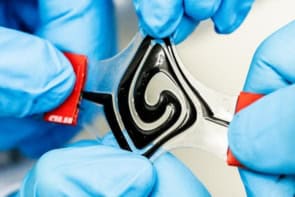
Domestic and industrial wastewater contains organic substrates and nutrients that could be used to produce biofuels, such as hydrogen, as well as to recover carbon if the right extraction method were found. A team of researchers in Spain has now put forward one such method that makes use of purple phototrophic bacteria, which can store energy from infrared light when an electric current is applied.
These microorganisms can recover nearly 100% of carbon from any type of organic waste while generating hydrogen gas for electricity production, explains co-team leader Daniel Puyol of King Juan Carlos University (URJC) in Madrid.
Purple bacteria
Purple phototrophic bacteria are extremely versatile thanks to their complex metabolic system that involves major carbon, nitrogen, sulphur, phosphorus and iron pathways, catalysed by various enzymes, he says. They absorb infrared energy through their photosystem, which is composed of carotenoids and bacteriochlorophylls. This means that they can be used to extract valuable products, such as biofuels like biohydrogen, bioplastics like PHA and even single-cell proteins, from waste sources.
The end product obtained very much depends on the environmental conditions in which the bacteria find themselves, however. These include the intensity of IR light they receive, surrounding temperature and nutrient concentration, to name but three parameters.
In their experiments, the researchers varied these conditions to tune the metabolism of the bacteria to different end-applications. For example, wastes rich in nitrogen help the bacteria to grow and produce biomass with a high protein content that can subsequently be used as an animal food additive. In organic waste lacking nutrients, the bacteria can amass large amounts of PHA (up to 70-90% w/w) and are thus an interesting alternative to fossil-fuels for producing plastics.
When the waste contains a lot of organic matter such as butyrate, it can be used produce biogenic hydrogen, a clean and renewable biofuel, by applying an electric current. “What is unique about our approach is that we use this current to optimize the productive output of purple bacteria,” says co-team leader Abraham Esteve-Nuñez of the University of Alcala. “This is possible since the different metabolic pathways rely on bioelectrochemical reactions that require a supply of electrons.”

Artificial photosynthesis and bacteria transform CO2 into speciality chemicals
Analysing the hydrogen-producing capacity of the bacteria
The researchers obtained their results by analysing the hydrogen-producing capacity of the purple bacteria when grown in various nutrient cultures containing different nitrogen and carbon sources. They inoculated the test samples with a mixed culture of the bacteria enriched from a wastewater influent taken from the pilot-scale wastewater treatment plant at URJC. They then exposed the cultures to near IR light.
The team found that maximum amount of hydrogen was produced using a mixture of malic acid and Na-glutamate and that this blend also minimized the production of CO2. It also found that when electrodes were connected to the culture, the bacteria again produced considerable amounts of hydrogen (by capturing electrons produced by the negative electrode, or cathode) but negligible traces of CO2.
“This result also suggests that the bacteria can interact with the cathode to extract electrons to capture more carbon from organic compounds via photosynthesis,” says Esteve-Nuñez. “This is the first time that a phototroph has been seen to adapt its metabolism due to interaction with an electrode.”
The study is detailed in Frontiers in Energy Research 10.3389/fenrg.2018.00107.



